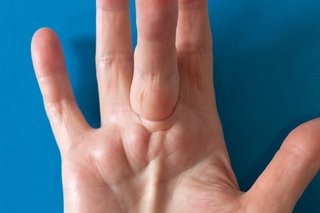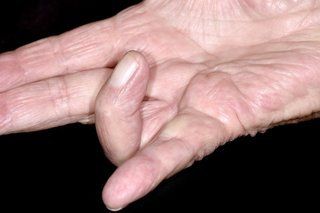Dupuytren's contracture is a condition that causes your fingers to bend in towards the palm of your hand.
Check if you have Dupuytren's contracture
Dupuytren's contracture mainly affects the:
- ring finger
- little finger
You can have it in both hands at the same time.
It starts with lumps, dimples or ridges on your palm. It usually gets slowly worse over many months or years and your finger may bend in towards your palm.


Conditions with similar symptoms to Dupuytren's contracture
- ganglion cyst - small, soft lump on your wrist or finger joints
- calluses - hard, raised, rough skin
- trigger finger - your finger "catches" or gets stuck when you move it
Non-urgent advice: Speak to a GP if 1 or more of your fingers are bent and:
- you cannot put your hand down flat on a table - this is the "tabletop test"
- you're finding daily activities difficult
Causes of Dupuytren's contracture
Dupuytren's contracture happens when tissue near your fingers becomes thicker and less flexible.
It has been linked to:
- having a family history of the condition
- smoking
- drinking a lot of alcohol
- having diabetes or epilepsy
Treating Dupuytren's contracture
There are 3 main types of treatment.
When you cannot put your hand down flat on a table, you will usually need treatment.
Speak to your GP about your options. They can refer you to a surgeon.
Surgery to straighten your fingers
Surgery to straighten your fingers is called a fasciectomy.
The surgeon makes a cut along your palm and finger so that they can straighten it.
For a fasciectomy:
- you can be under general anaesthetic (you're asleep) or local anaesthetic (your hand is numbed)
- you can leave the hospital the same day
- the recovery time is 4 to 12 weeks
The risks of a fasciectomy include:
- numbness in your finger
- wound healing problems
- infection
- stiffness
But 9 out of 10 patients have no problems after the surgery.
Using a needle to straighten your fingers
Using a needle to straighten your fingers is called a needle fasciotomy.
A needle is inserted into several places along your palm and finger to loosen and straighten it.
For a needle fasciotomy:
- you will be given a local anaesthetic (your hand is numbed)
- you can leave the hospital the same day
- the recovery time is up to 2 weeks
The risks of a needle fasciotomy include:
- a cut opening up in your skin
- pain
- numbness
Your contracture is more likely to come back with a needle fasciotomy than with surgery.
Using surgery and a skin graft to straighten your fingers
Using surgery and a skin graft to straighten your fingers is called a dermafasciectomy.
It is similar to a fasciectomy, except an extra area of skin is removed. A skin graft from somewhere else on your body can be used to replace the removed skin.
There are 2 procedures for a dermafasciectomy.
A procedure to:
- straighten your fingers
- add the skin graft - this happens around 4 days after straightening your fingers
For a dermafasciectomy you will have general anaesthetic (you will be asleep) or local anaesthetic (your hand will be numbed).
The risks of a dermafasciectomy include:
- bleeding
- numbness
- infection
Contractures are less likely to come back with a dermafasciectomy than with a standard fasciectomy. But recovery times can be longer.
What to expect after treatment
Your finger may not be completely straight after treatment, and might not be as strong and flexible as it used to be.
After treatment, you may:
- have a cast or splint on your hand for a few days
- have some pain, stiffness, bruising and swelling for a few weeks
- need to wear a splint while sleeping for 3 to 6 months
- be advised to do hand exercises for up to 6 months - a specialist hand physiotherapist will supervise your recovery exercises and rehabilitation
It is very important to start using your hand again for everyday activities a few days or as soon as possible after your operation.
It may be a few weeks before you can return to all your activities.
Whichever form of treatment is used, there is a risk of the condition returning.
Content supplied by the NHS and adapted for Ireland by the HSE
